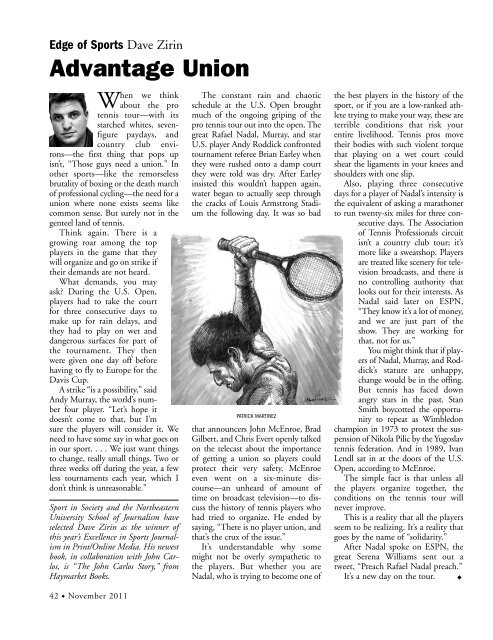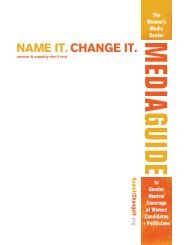Jodie Evans
Jodie Evans
Jodie Evans
Create successful ePaper yourself
Turn your PDF publications into a flip-book with our unique Google optimized e-Paper software.
Edge of Sports Dave Zirin<br />
Advantage Union<br />
When we think<br />
about the pro<br />
tennis tour—with its<br />
starched whites, sevenfigure<br />
paydays, and<br />
country club environs—the<br />
first thing that pops up<br />
isn’t, “Those guys need a union.” In<br />
other sports—like the remorseless<br />
brutality of boxing or the death march<br />
of professional cycling—the need for a<br />
union where none exists seems like<br />
common sense. But surely not in the<br />
genteel land of tennis.<br />
Think again. There is a<br />
growing roar among the top<br />
players in the game that they<br />
will organize and go on strike if<br />
their demands are not heard.<br />
What demands, you may<br />
ask? During the U.S. Open,<br />
players had to take the court<br />
for three consecutive days to<br />
make up for rain delays, and<br />
they had to play on wet and<br />
dangerous surfaces for part of<br />
the tournament. They then<br />
were given one day off before<br />
having to fly to Europe for the<br />
Davis Cup.<br />
A strike “is a possibility,” said<br />
Andy Murray, the world’s number<br />
four player. “Let’s hope it<br />
doesn’t come to that, but I’m<br />
sure the players will consider it. We<br />
need to have some say in what goes on<br />
in our sport. . . . We just want things<br />
to change, really small things. Two or<br />
three weeks off during the year, a few<br />
less tournaments each year, which I<br />
don’t think is unreasonable.”<br />
Sport in Society and the Northeastern<br />
University School of Journalism have<br />
selected Dave Zirin as the winner of<br />
this year’s Excellence in Sports Journalism<br />
in Print/Online Media. His newest<br />
book, in collaboration with John Carlos,<br />
is “The John Carlos Story,” from<br />
Haymarket Books.<br />
42 u November 2011<br />
The constant rain and chaotic<br />
schedule at the U.S. Open brought<br />
much of the ongoing griping of the<br />
pro tennis tour out into the open. The<br />
great Rafael Nadal, Murray, and star<br />
U.S. player Andy Roddick confronted<br />
tournament referee Brian Earley when<br />
they were rushed onto a damp court<br />
they were told was dry. After Earley<br />
insisted this wouldn’t happen again,<br />
water began to actually seep through<br />
the cracks of Louis Armstrong Stadium<br />
the following day. It was so bad<br />
PATRICK MARTINEZ<br />
that announcers John McEnroe, Brad<br />
Gilbert, and Chris Evert openly talked<br />
on the telecast about the importance<br />
of getting a union so players could<br />
protect their very safety. McEnroe<br />
even went on a six-minute discourse—an<br />
unheard of amount of<br />
time on broadcast television—to discuss<br />
the history of tennis players who<br />
had tried to organize. He ended by<br />
saying, “There is no player union, and<br />
that’s the crux of the issue.”<br />
It’s understandable why some<br />
might not be overly sympathetic to<br />
the players. But whether you are<br />
Nadal, who is trying to become one of<br />
the best players in the history of the<br />
sport, or if you are a low-ranked athlete<br />
trying to make your way, these are<br />
terrible conditions that risk your<br />
entire livelihood. Tennis pros move<br />
their bodies with such violent torque<br />
that playing on a wet court could<br />
shear the ligaments in your knees and<br />
shoulders with one slip.<br />
Also, playing three consecutive<br />
days for a player of Nadal’s intensity is<br />
the equivalent of asking a marathoner<br />
to run twenty-six miles for three consecutive<br />
days. The Association<br />
of Tennis Professionals circuit<br />
isn’t a country club tour; it’s<br />
more like a sweatshop. Players<br />
are treated like scenery for television<br />
broadcasts, and there is<br />
no controlling authority that<br />
looks out for their interests. As<br />
Nadal said later on ESPN,<br />
“They know it’s a lot of money,<br />
and we are just part of the<br />
show. They are working for<br />
that, not for us.”<br />
You might think that if players<br />
of Nadal, Murray, and Roddick’s<br />
stature are unhappy,<br />
change would be in the offing.<br />
But tennis has faced down<br />
angry stars in the past. Stan<br />
Smith boycotted the opportunity<br />
to repeat as Wimbledon<br />
champion in 1973 to protest the suspension<br />
of Nikola Pilic by the Yugoslav<br />
tennis federation. And in 1989, Ivan<br />
Lendl sat in at the doors of the U.S.<br />
Open, according to McEnroe.<br />
The simple fact is that unless all<br />
the players organize together, the<br />
conditions on the tennis tour will<br />
never improve.<br />
This is a reality that all the players<br />
seem to be realizing. It’s a reality that<br />
goes by the name of “solidarity.”<br />
After Nadal spoke on ESPN, the<br />
great Serena Williams sent out a<br />
tweet, “Preach Rafael Nadal preach.”<br />
It’s a new day on the tour. u



